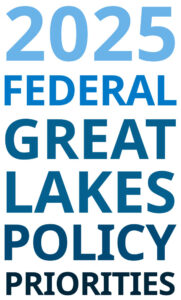Critical Months Ahead for the Great Lakes in Congress

On July 4th, President Donald Trump signed into law the “One Big Beautiful Bill Act” or “OBBBA.” Now that OBBBA is law, the focus in Congress turns to funding the government and passing legislation that is required to renew, or “reauthorize,” federal programs in the new fiscal year that starts October 1st.
On the funding side, the President’s proposed budget recommends deep cuts that would threaten the health of the Great Lakes and the people who depend on them. Congressional Republicans are unlikely to accept the full cuts, as some in their leadership have spoken out against some of the proposals, but important funding is still likely to be scaled back. Among the cuts would be funding to replace dangerous lead pipes, fix leaky pipes, and stop sewage overflows from entering our lakes and people’s homes.
On the fight to reauthorize key programs, there are some potentially positive signs, though some of the renewed programs may end up with less funding. Programs up for reauthorization cover fisheries management, water infrastructure, managing invasive carp, and on-the-ground restoration projects, from wetland restoration to cleaning up toxic hot spots.
At the Alliance, we’re following these developments closely and working to ensure that federal programs and policies protect and restore the clean, fresh water of the Great Lakes in a manner that promotes a sustainable economy and environment for Great Lakes residents.
The administration’s budget proposal threatens the Great Lakes, our public health, and our environment
The first order of business is Congressional action on the 12 annual spending bills that Congress must enact before the end of September, when the new fiscal year begins and current government funding runs out.
The FY 2026 President’s Budget that was submitted to Congress this spring proposes sweeping cuts to many federal agencies that significantly reduce domestic discretionary spending. For the Great Lakes, the proposed cuts risk the health of residents who rely upon the lakes as a source of drinking water because the budget proposes to eliminate nearly all of the $3 billion in water infrastructure funding that is provided annually to states. These steep cuts would make it difficult for Great Lakes states to address water infrastructure backlogs, replace lead service lines, address contaminant issues such as PFAS, and provide principal forgiveness for disadvantaged communities that struggle to construct expensive drinking and wastewater infrastructure because they may lack the tax base to do so. These are just a few of the problems with proposing to eliminate nearly $3 billion in annual federal funding that supports water infrastructure needs nationally. Information gathered by the Environmental Protection Agency indicates that the national backlog of water infrastructure needs is growing, not diminishing, over the next 20 years.
Although Congressional Republicans solidly supported the President in passing OBBBA, Congressional Republicans are unlikely to accept the proposed FY 2026 proposed budget cuts, as key Republicans in leadership positions have spoken out against some of the proposed cuts. As a result, on the House side where the individual appropriations subcommittees have begun to “mark up” the annual spending bills, the Interior and Environment Appropriations Subcommittee did not agree with the Administration to eliminate water infrastructure funds to states for both the Clean Water and Drinking Water State Revolving Funds (“SRFs”).
Notwithstanding this opposition to the Administration’s proposal, they did propose significant cuts totaling $661.9 million, or approximately 24%, of the funds for the nation’s primary source of water infrastructure funding. This means that the Great Lakes States will collectively lose $137.1 million. This loss is ameliorated by the fact that some Members of Congress from Great Lakes states pursued “Community Project Funding” where they directed funds from within these large federal appropriations to water infrastructure projects in their districts. If a Member of Congress secured such community-specific funding, the overall loss to their state is less than it would have been. The 24% cut to water infrastructure funding combined with the Community Project Funding would result in the following changes to water infrastructure funding compared to last year:
| State | Change in federal water infrastructure funding |
|---|---|
| Illinois | + $800,000 |
| Indiana | – $20,200,000 |
| Michigan | – $2,100,000 |
| Minnesota | + $28,800,000 |
| New York | – $53,200,000 |
| Ohio | – $23,500,000 |
| Pennsylvania | – $34,200,000 |
| Wisconsin | – $33,500,000 |
Although House Republicans are not fully embracing the Administration’s proposed cuts to water infrastructure funding, SRF funding to states under the House Interior Appropriations Subcommittee mark-up is less than last year, which is problematic for the reasons discussed above.
Similarly, Congressional Republicans on the House side are also not accepting the Administration’s proposal to eliminate the National Oceanic and Atmospheric Administration’s (“NOAA”) Office of Atmospheric Research, which funds numerous research facilities around the country and also in the Great Lakes, including the Great Lakes Environmental Research Laboratory (“GLERL”) in Ann Arbor, MI and the related research organization housed there known as the Cooperative Institute for Great Lakes Research or “CIGLR.” CIGLR is a public-private partnership of 10 research universities throughout the region, non-governmental organizations, and local governmental partners who tackle some of the biggest challenges facing the Great Lakes. These challenges include the monitoring of harmful algal blooms, or “HABs,” which are produced by agricultural runoff. CIGLR monitors HAB outbreaks, which occur during the summer months, to ensure that the Great Lakes drinking water in areas affected by HABs is safe to drink and to protect swimmers and fishermen from the effects of HABs – which can be fatal. Although the details are not yet available, the House Appropriations Subcommittee on Commerce, Justice and Science marked up its bill this week and proposes to only decrease NOAA’s Office of Atmospheric Research by $257 million, which leaves intact most of these functions. We have yet to determine whether GLERL or CIGLR is fully funded and able to maintain the functions it provides to Great Lakes States.
On the other side of the Capitol, the Senate has only started its process to develop the 12 annual spending bills and two senior Senators, Appropriations Chair Susan Collins, R-Maine (who voted against OBBBA) and Interior Appropriations Chair Lisa Murkowski, R-Alaska, have expressed doubts about supporting the Administration’s proposed cuts. The Senate’s Appropriations Subcommittee on Commerce, Justice and Science has begun to consider its bill funding NOAA programs, but halted its markup this week where it added back approximately $650 million for NOAA’s Office of Atmospheric Research. No further details are available on the Senate markup as it is not complete, but Senate Republicans are also not fully on board with the Administration’s funding proposals.
Although there is a great deal of uncertainty over how Congress will resolve its differences with the Administration on the FY 2026 budget, and the Congress must also consider a package of “rescissions” recently proposed by the Administration (canceling prior year spending), it is clear that the House and Senate are unlikely to pass any of the individual spending bills before Congress recesses in August. After Labor Day, Congress will devote its time to issues associated with enacting a budget for FY 2026 that begins on October 1st. Given this attenuated schedule, it is possible that there will be one or more continuing resolutions for FY 2026 which just extend current levels of annual funding for a period of time. We will closely monitor these developments and let you know how the annual funding process is unfolding.
Bipartisan support for continuing Great Lakes programs
With respect to other legislative issues affecting the Great Lakes, including reauthorization for the Great Lakes Restoration Initiative, reauthorization for the Great Lakes Fishery Reauthorization Act, reauthorization for the Clean Water Act’s State Revolving Funds, and the implementation of the Brandon Road Interbasin Project in Joliet, Illinois, that is intended to halt invasive carp from getting into Lake Michigan, there are some positive developments.
First, President Trump has publicly announced his support for both the Great Lakes Restoration Initiative (or “GLRI”) as well as the Brandon Road Project. For GLRI, which the Administration proposes to fund at last year’s enacted level, the bipartisan reauthorization bill, which has been reintroduced in both the House and Senate, has attracted numerous bipartisan cosponsors and is likely to pass during this session of Congress, which ends in 2026. We are working closely with a bipartisan group of Great Lakes Members of Congress to ensure that the bill moves through both the Senate Environment and Public Works Committee and the House Transportation and Infrastructure Committee, passes the House and Senate, and becomes law.
For the Brandon Road Project, President Trump issued a memorandum earlier this year directing federal agencies to move expeditiously to implement the project. The U.S. Army Corps of Engineers (“Corps”), which initiated project construction in late 2024, is doing just that. All contracts for the first phase of project construction are issued, and work is well underway. The Corps is working diligently with its local partners, the States of Illinois and Michigan, to get ready for the next phase of construction (slated to begin in the fall of 2026), which requires an additional transfer of lands from the State of Illinois to the Corps. This land transfer is scheduled to occur before September 2025 so that the Corps may begin site testing and preparation of these lands and remediation of any contamination as necessary. No additional federal funding is needed until FY 2027, and the project is on track thanks to the diligent work of the States of Illinois and Michigan and the Corps.
Other legislative reauthorizations are moving, with the schedule largely dictated by the Administration’s transition, which is unprecedented in scope in terms of actions that affect federal agency budgets, staffing, regulations and policy, as well as judicial review. At the Alliance, we work to stay on top of these changes and to inform and educate decision-makers on the effects of proposed actions. As another source of good news, the Great Lakes Fishery Research Reauthorization Act just passed the House this week and may now be considered by the Senate. Work is also underway among authorizing staff to prepare for the reauthorization of the Clean Water and Drinking Water State Revolving Funds, which must be reauthorized by the end of 2026; we are working that issue as well.
We will continue working on all these issues as they move through Congress. We are hopeful that the Administration’s support for both GLRI and Brandon Road, and the awareness of how numerous federal programs support the Great Lakes and its people, will result in final actions on funding and legislating that protect the Great Lakes.
If you have any concerns about proposals and actions in the federal legislative or executive branch that are being considered, we encourage you to contact your Congressional representative to express your views using the action alert below.
The post Critical Months Ahead for the Great Lakes in Congress appeared first on Alliance for the Great Lakes.
News - Alliance for the Great Lakes
News - Alliance for the Great Lakes
https://greatlakes.org/2025/07/critical-months-ahead-for-the-great-lakes-in-congress/






